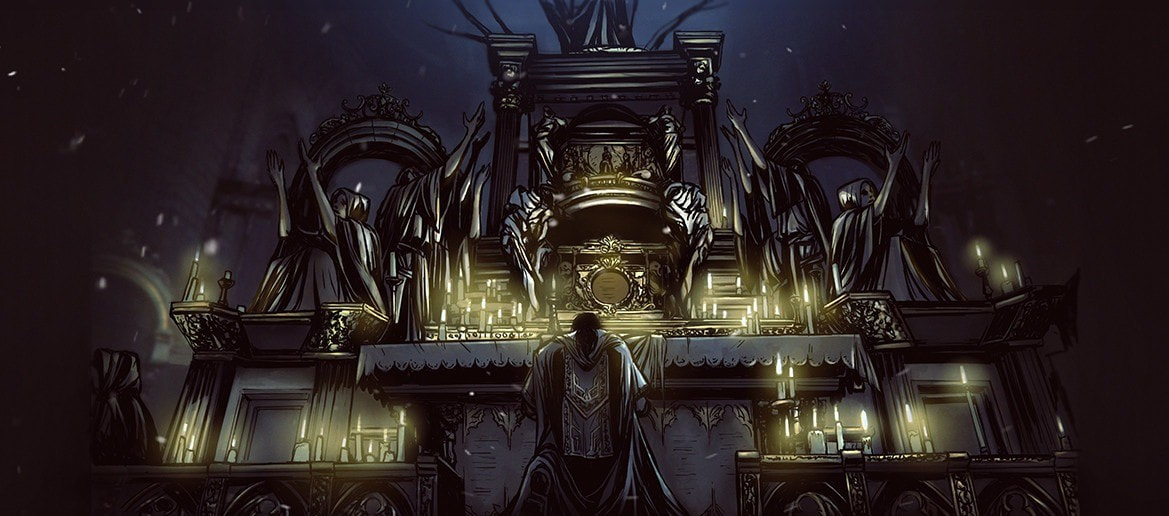 Lorecraft has become especially popular in recent years thanks to games like Dark Souls and Bloodborne, and with its resurgence as a storytelling mode, many creators both professional and amateur are attempting to carve out their own plot of narrative real estate. This isn’t a new frontier, however, and savvy world builders would be wise to recognize that. Lore is all about longevity, about reaching from the past to inoculate those of the future. With this in mind, try to think about something, anything that has existed in its original, unmolested state for, say, one hundred years. What about two hundred? Or a thousand? The simple answer is none, but “simple” seldom makes for satisfying stories. That, at its heart, is what lorecraft is all about. It is simulating the persistent effect of time on a culture, idea, structure, or even a single person. It is telling the story (whatever that story may be) as it was by how it is now. To do this, you need a story that can turn into lore; here are some tips on how to do just that. 1) Structures Think about lore as footprints or tracks that players have to trace backwards. Unlike conventional storytelling where the narrative unfurls before the protagonist, lore and legend by their very nature require that at least part of the story has already been told. But you already know that. You have already stepped in those footprints before, you remember. Don’t you: the house down the street, with the loose-hinged shutters sun bleached and dropping jagged paint chips like leaves from a maple tree. Derelict and abused, the house is perched on your street like a gargoyle, watching the jittering plans of you and your neighbors for years. Local children would bribe one another with melted snickers to go inside on hot summer nights when the moon was brightest. Some would go in, plucking up the courage (or naïveté) only to rocket out screaming from the houses yawning doorway. You remember hearing about the night she went in. You remember waiting for her to come out, the kids around you calling out her name in nervous laughs. You remember eventually going home. You don’t remember seeing her again. The haunted house! Everyone has at least heard of one! It’s a great way to build micro-lore that resonates with a lot of people. This idea of a physical structure that’s mere existence compels those nearby to fabricate a story around it. It’s an important part of culture, crafting legends around structures, and we have been doing it for thousands of years. Houses of worship often fall into this column, but we will get to religion in a bit. For now, be thinking of lore in the way you think of that haunted house. What makes it unique? What makes it memorable? Most of the time, it’s the aesthetic. It’s the fact that it isn’t like the surroundings. It possesses an air about it that begs for a story. All the important ancient structures that exist today exhibit that. Maybe at one time they fit right in, but something happened. Everything changed and for one reason or another, it had the tenacity to brave the storm of time. So often, buildings don’t stand the test of time; that is why I said it’s great for micro lore. It helps creators get a grasp on the idea of persistence and setting because lore has a tendency to lean on the philosophical. Without a strong presence of mood and setting to ground wayward protagonists, lore might just be perceived as a history lecture. Buildings like temples, pyramids, even creepy homes are a good way to avoid some of the wordiness of legacy and provide engaging avenues to show rather than tell. History is learned. Lore is explored. Keep that in mind with buildings. 2) Folktales This may be the most familiar form of lore that we digest today. Stories of heroes of a bygone era and the adventures they undertook is the soul of most roleplaying games. While players often are participating in reactive story telling (The monster is doing this; so, you do this), lore is post-active storytelling. The analogy of the footprints is especially true for folk tales and post-active narratives. For example, one of my favorite Native American folktales from the Muscogee tribe describe the events that lead to opossums having bald tails. In short, a clever opossum catches his tail alight to bring fire to those that needed it most, Prometheus style. Post-active storytelling does not have much of a pension to be changed on the fly, but its results are able to be engaged with and are usually the reason the story is being told in the first place even if that reason is “I wonder why opossums have bald tails?” Folktales are a way to humanize history through lore. It is a vehicle that allows us to make an impression on one of the most difficult surfaces to reach: the past. If you want to build character-centric lore, go to the folktale and see what makes them tick. Soon, you will be begin to notice that classically there are uncanny archetypal characters that mirror other characters from vastly different locations and points in history. Folktales palletize grandiose ideas of the human experience, but at their heart, they tether the present to the past through caution and familiarity. The best heroes of lore, despite how godlike or untouchable, are always actualized by what makes them most human. 3) Religion The backbone of most prominent religions presently is preservation. Someone thought that the world works/should work a certain way, and they made sure that their ideology could be propagated beyond their lifetime. It’s a pretty daunting task. Regardless of validity, religions deserve a pat on the back for lasting as long as they have. This deliberate, theological persistence is engineered to imbed itself into culture to survive; it does this through lorecraft. For sake of illustration, let’s make up a religion. A group of intelligent creatures live on the shoreline of a massive sea. Every once in a while they see curious beasts ferrying men across the water. These beasts have large white structures that catch the wind and propel them forward. Without the technology to observe these things closer, the little colony agrees that the beasts must be some massive water bird capable of carrying humans over past the horizon. “Well what is on the other side of the horizon?” one asks. “Who knows? Everyone that goes out there never comes back,” replies another. There is the seed. Mystery, intrigue, mortality. Over the next couple of generations this seed grows and evolves as more people throw their theories into the ring, and before you know it, we have a fully fleshed out mythology about gatekeeping birds transporting chosen humans into another realm. As silly as it sounds, Americans actually tried to synthesize a religion to keep people out of nuclear test sites in this very way (Vox and the podcast 99% Invisible have an amazing video on this which can be found here https://www.vox.com/videos/2018/1/29/16932718/biohazard-design-nuclear-waste). Take an icon. Let that icon grow bigger in scope though intrigue, and once it grows too big or esoteric for people to completely understand, eventually someone is going to stand up and say, “Hey what if we aren’t supposed to completely understand? Maybe it is supernatural.” We mentioned before that folklore was designed to connect the human condition to the often foggy interpretation of the past. Religion connects the human condition to the supernatural in much the same way. It’s important to keep in mind that rich lore often deals with the mortality of man and the anxiety it can induce. Throughout human history the desire to feel like the unexplainable is being orchestrated by something bigger than man has cropped up again and again. We build lore around it to contain the philosophical musings that we feel are most satisfying. When it comes to religion, think of lore as a glass terrarium that not only provides enough structure to keep everything in one place but also remains transparent enough so that we can see whats inside. 4) Monsters If folktales highlight the best in human design, then monsters are the downers at the party that point out how awful things are. In a way, the story of the monster is the antithesis of the folktale. If folktales tell us, “Hey, humans can transcend themselves and do amazing things,” the monster story warns us, “Humans can transcend themselves, but you may not like what the end result looks like.” We see great examples of that warning in familiar stories like “Frankenstein,” “The Shadow Over Innsmouth,” basically all werewolf and vampire stories, and so many more. The next time you read or watch something about a monster shift your perspective and try to see it as the protagonist. More often than not there is a sympathetic turn; a genesis story of sorts. Your lore alarm should be buzzing right about now. While most lore is about taking steps back in time, the specific lore surrounding monsters often has us taking steps back to scrutinize ourselves (specifically our psychology). Where monsters are concerned, good lore builders are able to hold up a mirror and make you see something worse than your reflection. I don’t know about you, but my usual reflection is bad enough. Take the idea of the classic Kraken myth. It’s not scary because it has tentacles or is impressively large or even that it eats boats. It’s scary because it has alien motivations and wants to eat your boat. It embodies the fears of many sailors and the anxiety of traveling into the unknown, an anxiety that keep many people for exploring anything at all. The Kraken has effective lore because it begs the question, “Why is it scary?” One more example: the witch. In fact, watching the movie “The Witch” tries to convey much of what I have already said about monsters. The archetype of the witch has us asking, yet again, why we are so concerned with relatively innocuous things when seen at face value. Old ladies are not scary, per se. Neither is magic nor the idea of the supernatural. The witch has been so alarming for much of English, Irish, and German history because of what it represents to humans in a general way. The lore behind the witch gives it its weight. The concept of dark, corrupting knowledge that poisons your very nature and potentially those around you is terrifying, especially for colonials during that time. The idea of the “other” has lead people to do terrible things, but the lore behind it is important. Lore helps us tackle these issues with a degree of skeptical separation. Lore is a powerful tool at a creator’s disposal, but getting bogged down in time lines, he-said-she-said, and esoterica can really detract from the heart of what makes lore compelling. That is, our actions matter and can echo through time long after we are gone. An old professor said something to me once that I still think about today when I’m writing story: “The most engaging part of a treasure hunt is why it needs to be hunted in the first place. If you don’t know that, you’re just writing about a dirty box full of scrap metal.” Andrew Pendragon is a veteran role player, Dungeon Master, and story teller. His work can be seen featured on outlets like the Simply Scary Podcast and Youtube channel BlackEyedBlonde, but he takes the most pride in his High Level Games affiliate podcast The Dragon’s Horde where he, alongside his co host, answers listener submitted roleplay questions and weaves them into a false-actual-play. Picture Reference: https://funnyjunk.com/channel/vidyagaems/Bloodborne+lore+ilustrado+ludwig/wYGsLjL/ Leave a Reply. |
All blog materials created and developed by the staff here at High Level Games Archives
April 2023
Categories
All
|
Proudly powered by Weebly



 RSS Feed
RSS Feed